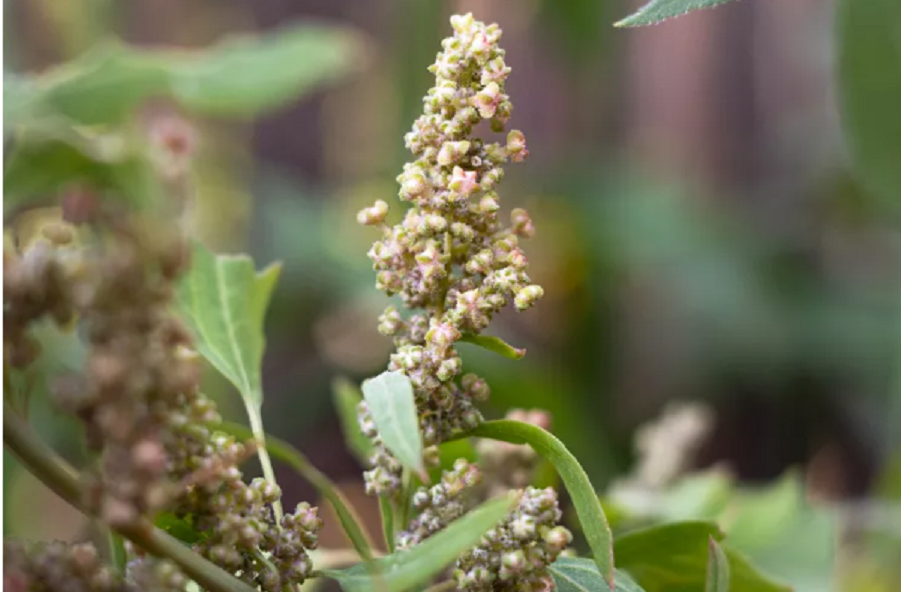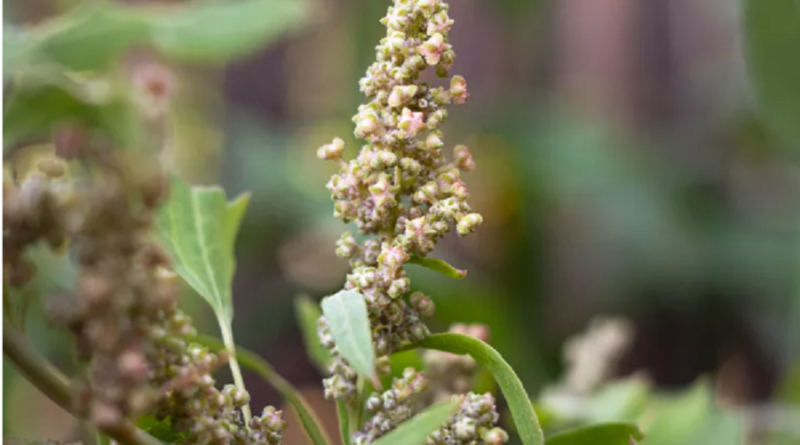Cultivation of Quinoa

Introduction ;
Quinoa (Chenopodium quinoa) belongs to the amaranth family native to Latin America and has been designated a crop for food and nutritional security by the FAO Quinoa is an herbaceous annual plant grown as a crop primarily for its edible seeds
Despite its high nutritional value and ability to adapt to harsh weather, climate, and soil conditions. (India’s arid and semi-arid regions.) The quinoa crop can give a good return to the farmers
India’s Market Potential for Quinoa;
Quinoa currently has a small market in India. A concerted effort needs to be made to educate the populace about quinoa, including its definition, cooking methods, and processing techniques, to create products with added value.
Although some farmers have already begun cultivating their crops, there isn’t a strong market for buying their produce. If the right precautions are taken, the yield potential is very high, and the financial returns will be favorable as long as processing facilities are set up and value-added products are extensively advertised.
The Indian quinoa market was estimated to be 77,580.0 tons in 2023. Looking ahead, IMARC Group expects the market to reach 469,322.2 tons by 2032, with a compound annual growth rate (CAGR) of 21.5% from 2024 to 2032.
Prominent brands in India that offer high-quality quinoa include Erika Organics, NatureVit, Sattvic Foods, Yoga Bar, and Bliss of Earth.
Health Benefits of Quinoa Intake
- Quinoa is a plant-based source of protein and an excellent dietary choice for vegetarians or vegans.
- High fiber content: Diets rich in fiber may also promote weight management. This is because foods high in fiber help people feel fuller for longer, potentially reducing a person’s overall food intake.
- A source of antioxidants, quinoa provides vitamin E. This antioxidant compound may help reduce the risk of coronary heart disease, certain cancers, and several eye disorders.
- It helps meet manganese requirements, which are essential for development and metabolism. This element also works alongside many enzymes in the body to support their function.
- Rich source of iron; adequate iron intake also supports healthy connective tissue and muscle metabolism.
- A source of folate; getting enough dietary folate might also reduce the risk of several cancers and depression. Pregnant women may only be able to get enough folate by taking folic acid supplements.
- Provides magnesium; magnesium is essential for the function of more than 300 enzymatic reactions
- It Contains quercetin and kaempferol; These antioxidants may protect against a range of chronic conditions. Kaempferol may help protect against infection, heart disease, diabetes, and several cancers. Highly respected database from the National Institutes of Health
Nutritive Value of Quinoa ;
| Comparison of quinoa with mainstream cereals and legumes (values are based on dry weight) Source: Agriculture and Food | ||||||
| Crop | Fat (g/100g) | Protein (g/100g) | Ash (mineral constituents) (g/100g) | Fibre (g/100g) | Carbohydrates (g/100g) | Energy (Kcal/100g) |
| Quinoa | 6.3 | 16.5 | 3.8 | 3.8 | 69 | 399 |
| Rice | 2.2 | 7.6 | 3.4 | 6.4 | 80.4 | 372 |
| Barley | 1.9 | 10.8 | 2.2 | 4.4 | 8.7 | 383 |
| Maize | 4.7 | 10.2 | 1.7 | 2.3 | 81.1 | 408 |
| Wheat | 2.3 | 14.3 | 2.2 | 2.8 | 78.4 | 392 |
| Lupin | 7 | 39.1 | 4 | 14.6 | 35.3 | 361 |
| Beans | 1.1 | 28 | 4.7 | 5 | 61.2 | 367 |
| Soybean | 18.9 | 36.1 | 5.3 | 5.6 | 34.1 | 451 |
Cultivation practices: Quinoa Crop;
Required Soil for Quinoa Crop ;
- Loamy-sand to sandy-loam soils are ideal for this crop’s growth. Quinoa can be grown in lower natural fertility soils, poor or excessive drainage, or extremely acidic (pH 4.8) to alkaline (pH 8.5) conditions.
- This crop can also be grown in the murum soils (sedimentary rock composed of small, rounded particles of sand, clay, and silt). It is usually found in arid or semi-arid regions. Murum-type soils have good drainage.
Required weather conditions for the Quinoa crop:
- Short days and cool temperatures are necessary for quinoa to thrive. Additionally,
- It can be grown in marginal agricultural areas with low-fertility soils and a high drought risk.
Growing quinoa in regions with shorter days will result in earlier flowering.
Although it can be grown in acidic soils with a pH of 0 and alkaline soils with a pH of 9.0, quinoa prefers neutral soils. - Although it can tolerate temperatures ranging from 36°C to -8°C, quinoa grows best at temperatures between 18 and 20°C. According to research, temperatures above 36°C tend to induce pollen sterility or plant dormancy, ultimately preventing plants from setting.
- When planted in India during the Rabi season (mid-October to mid-December), this crop responds very well to the climate and produces more seeds.
Land preparation for Quinoa Cultivation;
- To prevent waterlogging, quinoa needs a level and well-drained seedbed.
- The ridge and furrow system reduces the likelihood of waterlogging causing initial damage to seedlings, which will yield more.
- The murum soil should be free of large stones and contain a healthy amount of organic matter to retain moisture for the first eight to ten days.
Manuring & fertilization Requirements for Quinoa Crop;
- Incorporating FYM at a rate of 15–20 tonnes per hectare prior to land preparation will improve the initial vegetative growth.
- For a good yield, a fertilizer dose of N: P: K @ 100:50:50 kg per hectare is advised.
- Nitrogen fertilizer works well for quinoa, but it shouldn’t be used more than 60 to 80 kg N/acre. Because of slower maturity and more intense lodging, yields decrease with higher levels of available nitrogen.
Method of Quinoa Crop Seed Sowing;
- Seeds should be sown 2 to 5 cm deep, depending on the type of soil and the amount of moisture present. Better plant stands are produced in moist soil conditions.
- Due to its small size, the seed is vulnerable to waterlogging and dehydration if planted too deep or too shallow.
- A good crop stand can be achieved with a seed rate of 500 to 750 grams per acre.
- In less-than-ideal growing conditions, seed rates typically double. Combining the seeds with the sieved soil in a ratio of 1 (seed): 3 (soil) provides better germination and helps achieve the necessary plant stand.
- According to field tests, a higher plant density led to less plant branching, a slightly earlier maturity, and a higher seed yield.
Irrigation Requirement for Quinoa Crop ;
This crop can withstand some drought. Research on crop water use revealed that applying less water resulted in a 50% reduction in plant height and only an 18% yield reduction.
After establishing a stand, excessive irrigation typically results in tall, lanky plants that do not increase yield. Excessive irrigation during the seedling stage will cause plants to damp off and severely stunt.
Pest and disease management of Quinoa Crop;
When a crop like quinoa is brought to a new production area, it may lead to issues with pests and disease. Quinoa fields have been found to harbor viruses that are typically found on beets or spinach. Nevertheless, no adequate investigation has been carried out to ascertain whether any of those result in substantial harm. Although a wide range of insect pests can harm quinoa, from seed germination to harvest and seed storage, entomologists do not currently believe that insect issues will limit quinoa production’s yield.
Harvesting of Quinoa Crop;
When plants reach maturity, their seed heads resemble sorghum. Harvest typically starts when the plants have dried, turned pale yellow or red, and the leaves have fallen off, and the seed can hardly be dented with a fingernail.
At this stage, the seed should thresh easily by hand. Plants can be harvested with ease, and field dry-down is typically acceptable. Since mature seeds will germinate within 24 hours of being exposed to moisture, rain during harvest will cause issues. An average yield of 5 to 15 q per ha is typically anticipated.
Threshing and storage Quinoa Crop;
With a hammer and fanning mill, the harvested panicles are easily threshed. To separate stover from seeds, the panicles can be winnowed against the direction of the strong wind and threshed under small tractor wheels. Because quinoa seeds are small and lighter than cereal grains, smaller screens are used. A fanning mill and gravity separator are typically required to remove trash from the seed. When being stored, the seed needs to stay dry. The saponins in the pericarp of quinoa are eliminated either mechanically, using a rice polisher or a machine like those used to remove wheat bran or soak it in water before food processing. Because of its high protein content, quinoa farming in India has a promising future.

